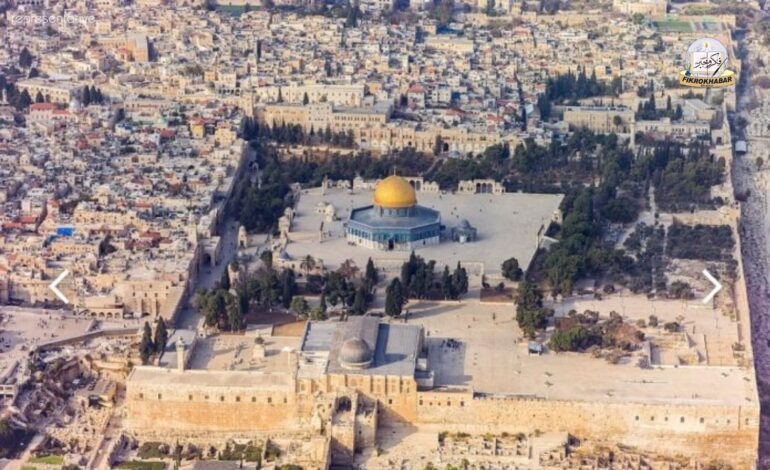A Horror of Half a Century- Not Just a Few Years

HOUSTON (USA): Two years have passed since the launch of “Al-Aqsa Storm.” The U.S. and the Western world are mourning the Israeli prisoners of war held in Gaza. US President Donald Trump, with a choked voice, said that not a single day has gone by in the past two years when he has forgotten the “apocalypse” that befell innocent Israelis on October 7, 2023.
But who will explain to Mr. Trump that the incident two years ago was not an “apocalypse,” but a prison break — while millions of Palestinians have been living through a real apocalypse in exile within their own homeland since 1948?
The arrogant may never understand, but for readers of conscience, here is some historical context of this tragedy:
A Strip of Land and a Crushed People
The Gaza Strip, located on the eastern coast of the Mediterranean, is merely 41 kilometers long and 6 to 12 kilometers wide. On its 365 square kilometers of land, over 2.4 million people live — about 6,500 per square kilometer.
Once part of the Ottoman Caliphate, Gaza was colonized by Britain in 1918. Then on 29 November 1947, the UN accepted the British mandate and proposed the Partition Plan. In classic British “justice,” 32% of the population (Jews) were given 56% of the land, while Palestinians, the majority, were left with only 42%.
Significantly, Bethlehem — the birthplace of Jesus — and Jerusalem were designated Corpus Separatum, or shared heritage, under international governance. In the areas allotted to Israel, there were 500,000 Jews and 438,000 Arabs, while the Palestinian regions had 10,000 Jews and 818,000 Arabs.
Occupation Begins — Al-Nakba al-Kubra
As soon as the partition was announced, armed Jewish groups began attacking Arab regions. The British forces, responsible for maintaining peace, watched passively and, in fact, handed over their arms to the Israelis before leaving.
On 5 April 1948, one month before the British left, Israeli forces entered Jerusalem — a violation of the UN resolution that prohibited weaponry in the area. Unarmed Palestinians tried to resist but were crushed. Among the many killed was Abdul Qadir al-Husseini, the nephew of the Grand Mufti.
The UN had clearly stated that the partition was temporary, and not a foundation for statehood. Nevertheless, on 14 May 1948, David Ben-Gurion declared the establishment of the State of Israel (Eretz Yisrael) — immediately recognized by both the USA (under President Harry Truman) and the USSR (under Joseph Stalin).
With the formation of Israel, its military surrounded Palestinian villages and forcibly expelled around 700,000 people, herding them like cattle toward Gaza. The coast was sealed off, and Gaza was turned into an “open-air prison.” The forced expulsion was completed on 15 May 1948, known to Palestinians as Yawm al-Nakba — The Day of Catastrophe.
The Wall of Apartheid and the Oslo Deception
In the war of June 1967, Israel captured Gaza and the Sinai Desert. Later, during peace talks, the 1993 Oslo Accords nominally handed Gaza’s administration to the Palestinian Authority (PA) — but the occupation remained.
Thus, the violence that erupted two years ago wasn’t a sudden explosion — it was the outcome of continuous oppression since 1948.
The recent tensions stemmed from the ultra-right-wing Israeli government formed in December 2022. This government was described as “racist” even by Tamir Pardo, former chief of Israel’s spy agency Mossad.
Even earlier, U.S. President Jimmy Carter had called the wall dividing Israeli settlements from Palestinian areas the “Apartheid Wall”.
Jerusalem and the Challenge to Status Quo
Since Ottoman times, Jerusalem has been divided into West (Jewish Quarter) and East (Muslim Quarter). The Al-Aqsa Mosque, its surrounding plaza, and the Dome of the Rock are in the eastern (Muslim) side.
After Israeli occupation, a UN-supervised agreement maintained this division. Under the Status Quo Law of 1757, Muslims were not to enter the western part, and non-Muslims were barred from entering the eastern part without permission.
However, Israeli ministers — including Itamar Ben-Gvir (Minister of Internal Security) and Bezalel Smotrich (Finance Minister) — consider this law “unjust.” Ben-Gvir has said that while Al-Aqsa is Islam’s third holiest site, the Temple Mount (Har HaBayit) is the most sacred for Jews. He has personally entered the mosque’s courtyard under military escort multiple times.
When his actions drew condemnation in the UN Security Council, Israel’s permanent representative Gilad Erdan argued that Israel’s past agreement to the Status Quo (1967) was a result of unfair international pressure.
Al-Aqsa Storm: A Blast Built on Years of Pressure
Daily Israeli raids in the West Bank, bombardments on Gaza, and the growing ties between Saudi Arabia and Israel rubbed salt into Palestinian wounds. The final blow came in September 2023, when the Israeli Minister of Communications visited Riyadh as a royal guest and even performed Jewish prayers there.
In response, on 7 October 2023, after an Israeli bombing on October 6, the people of Gaza launched “Al-Aqsa Storm.” Over 5,000 rockets were fired, border posts captured, and several military fortresses overrun. High-ranking officers like Colonel Roy Levy and Colonel Jonathan Steinberg were killed. Hundreds of Israeli soldiers were taken captive.
Despite its advanced technology, Israeli intelligence agencies Mossad and Shin Bet (Shabak) were caught off guard. The bold planning and bravery of Palestinians shattered Israel’s image of being “invincible.”
War Mania — and Netanyahu’s Political Survival
Ironically, the violence stabilized Prime Minister Netanyahu’s faltering government. Before Al-Aqsa Storm, his judicial reform bill had sparked massive protests and opposition — even allies like the U.S. and EU had expressed concerns about Israel’s democratic backsliding.
But the war frenzy drowned out cries for democracy, judicial independence, and freedom of speech. The opposition dropped its resistance and joined an “emergency cabinet.”
Saudi-Israel Romance Falters
While the conflict saved Netanyahu politically, it derailed the normalization of diplomatic ties between Saudi Arabia and Israel. Right after the October 7 attack, U.S. Secretary of State Antony Blinken urged the Saudi and Qatari foreign ministers to condemn the assault — but both countries blamed Israel’s own actions for the bloodshed.
According to Bloomberg, “Just before October 6, Riyadh and Tel Aviv were very close to signing a historic normalization deal — but the Palestinians set fire to America’s dream of a re-shaped Middle East.”
A Lost Life — But Not Lost Hope
Despite two years of devastation and more than half a century of dispossession, the people of Gaza still have their eyes set on the dawn of freedom.
Even under the open skies of what is essentially a prison, their hope and resilience remain unbroken.
This Article is Published by: India Tomorrow



